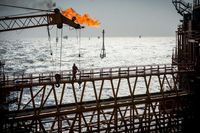Oil prices have been on the rise for the third consecutive day as fresh U.S. sanctions against Iran have caught the attention of investors. The new measures particularly target a Chinese refinery for allegedly purchasing Iranian crude oil, marking a significant escalation in U.S. efforts to curb the flow of Iranian oil into international markets. Brent crude prices jumped to over $72 a barrel, poised for its most substantial weekly gain since January, while West Texas Intermediate (WTI) climbed to just below $69 per barrel.
As of March 21, 2025, the global benchmark Brent crude was priced at $72.14 per barrel, reflecting an increase of 14 cents, or 0.2%. Simultaneously, WTI crude futures surged by 16 cents, or also 0.2%, reaching $68.23 per barrel. Analysts predict that this upward momentum is set to continue, with both Brent and WTI on track for a nearly 2% rise on a weekly basis for the first time in 2025.
The United States Treasury's sanctions, which were announced on March 20, 2025, target not only the Chinese refinery but also the refinery's CEO, as part of Washington's ongoing strategy to intensify pressure on Iran. According to RBC Capital Markets analysts, these sanctions present "a clear escalation in sanctions policy." They contend that while the physical implications might be limited, it is essential for the market to acknowledge this risk, as it could lead to stronger price fluctuations due to supply concerns.
Reflecting on the sanctions, RBC Capital Markets noted, "While the physical implications are minimal, we think it reasonable that risk premium here is taken more seriously." This perspective echoes the sentiments of other analysts, including those from ANZ Bank, who anticipate that tighter sanctions could result in a reduction of Iranian crude exports by approximately 1 million barrels per day (bpd). Reports indicate that Iranian crude oil exports were about 1.8 million bpd in February, illustrating the potential impact of the newly imposed restrictions.
In addition to the sanctions, the organization OPEC+, which comprises OPEC members and other oil-producing nations, is also playing a crucial role in shaping the market dynamics. Earlier in March, OPEC+ members committed to further production cuts to compensate for exceeding their agreed quotas. The recently announced plan details that seven member countries will implement output cuts ranging from 189,000 bpd to 435,000 bpd, with these reductions set to last until June 2026. This move comes as OPEC+ previously confirmed an increase in production of 138,000 bpd, effective April 2025, intended to reverse some of the 5.85 million bpd of production cuts established since 2022 to support market stability.
Despite these efforts, analysts caution that the effectiveness of OPEC's new plan remains uncertain. ING analysts pointed out, "While the group shares a plan for compensation cuts, it certainly doesn't mean members will follow it. A handful of members have consistently produced above their target production levels," indicating a potential challenge to achieving the desired market balance.
The combination of U.S. sanctions and the OPEC+ production adjustments has fueled optimism about oil demand, particularly in the U.S., which is the world's largest consumer of oil. As consumption expectations rise, speculators are closely monitoring how these geopolitical factors will affect prices at the fuel pump.
In summary, the oil market is experiencing significant adjustments driven by newly imposed U.S. sanctions targeting a Chinese refinery for engaging in transactions with Iran. As Brent and WTI crude prices rise due to this development and the anticipated output cuts from OPEC+, traders remain vigilant regarding the balance of supply and demand in the coming weeks. Experts suggest that the combined effects of these sanctions may lead to tighter supply, which could have lasting implications for global oil prices.



